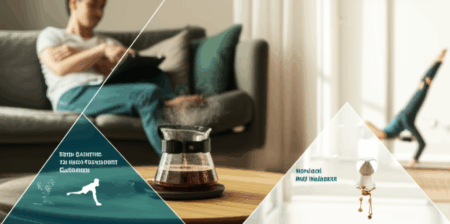In an era where sculpted physiques and rigorous workout routines dominate social media feeds, the line between healthy fitness and dangerous obsession can blur. What begins as a pursuit of well-being can, for some, devolve into a relentless and often secretive battle with an altered body perception, known as vigorexia. This psychological condition, also called muscle dysmorphia or the Adonis complex, is increasingly fueled by the curated realities presented on platforms like Instagram and TikTok, pushing individuals toward self-destructive behaviors in the elusive quest for an idealized physique.

Understanding Vigorexia: More Than Just a “Gym Obsession”
Vigorexia, also known as muscle dysmorphia or “reverse anorexia,” is a mental health condition characterized by an obsessive preoccupation with increasing muscle mass and achieving an idealized physique. Individuals suffering from vigorexia perceive their bodies as small and insufficiently muscular, even when they are objectively well-built. This distorted body image leads to compulsive exercise, primarily strength training, strict dietary regimens often high in protein and low in calories, and a significant risk of metabolic and psychiatric issues.
Unlike a healthy dedication to fitness, vigorexia leads to the neglect of other life aspects, such as family, friends, work, or studies, as the quest for muscularity takes precedence. It’s an intense fear of being small or weak that drives these individuals, often culminating in harmful behaviors. While predominantly affecting men, especially those aged 25 to 35, recent studies indicate a rise in muscle dysmorphia symptoms among young Europeans, impacting women as well.

The Magnetic Pull of Social Media: Fueling Unrealistic Ideals
Social media platforms have become a primary driver in the rise of muscle dysmorphia and body image disturbances. Constant exposure to “fitness lifestyle” content and images of hypermuscular bodies on platforms like Instagram, TikTok, and YouTube significantly increases the risk of developing symptoms.
The “Perfect” Physique Trap
Media advertising, streaming content, and social media consistently project an idealized male image—hypermuscular, lean, and seemingly in control—linking this appearance to success, strength, and social validation. Studies show that such ideals foster frustration and constant comparison, particularly when athletes, actors, and musicians showcase these images of physical perfection. This phenomenon, sometimes called “physique inflation,” creates an unrealistic standard where even impressive physiques are deemed “mid” or inadequate when compared to the often-enhanced or filtered images online. For women, pressure often remains confined to a thin, flawless body image, reinforcing gender-specific patterns of body dysmorphia.
The Role of Filters and Engagement
The use of photo filters, ubiquitous on platforms like Snapchat, Instagram, and TikTok, has a concerning link to increased muscle dysmorphia symptoms. Boys and young men who frequently use these filters report significantly higher scores for “Drive for Size” and functional impairment related to their body image concerns. Furthermore, posts depicting higher muscularity and lower body fat often receive significantly more engagement, such as likes and shares, which perpetuates these narrow beauty standards. This ongoing social comparison, amplified by likes and followers, deepens body dissatisfaction. When influencers fail to disclose the use of performance-enhancing drugs (PEDs), it can lead their audience to believe such enhanced physiques are naturally attainable, fostering feelings of inadequacy.

Recognizing the Warning Signs of Vigorexia
Identifying vigorexia can be challenging, as sufferers often appear physically healthy and their obsessive behaviors may initially seem like dedication. However, several key indicators can help distinguish healthy fitness from an unhealthy obsession.
Behavioral Indicators
- Compulsive Exercise: Engaging in strenuous workouts for excessive durations, often ignoring rest days or pushing through injuries.
- Rigid Routines: Experiencing extreme anxiety or stress when a workout session or meal is missed.
- Obsessive Dieting: Adhering to strict, low-calorie, high-protein diets and constantly worrying about meeting daily protein intake goals.
- Mirror Checking/Avoidance: Constantly scrutinizing one’s body in the mirror for imperfections or, conversely, avoiding mirrors if a workout has been missed.
- Social Isolation: Neglecting family, friends, work, or hobbies to maintain workout schedules or avoid situations where their body might be visible or critiqued.
- Substance Misuse: Turning to anabolic steroids, hormones, diuretics, or excessive supplements to enhance muscle growth, often overlooking significant health risks.
Physical and Psychological Symptoms
Individuals with vigorexia frequently experience anxiety and depression, driven by a distorted perception of their body image. Other symptoms can include insomnia, muscle pain, tremors, decreased sexual performance, and irritability. They may also exhibit low self-esteem and perfectionism.

The Dangerous Consequences of Obsessive Fitness
The pursuit of an idealized muscularity, particularly when driven by vigorexia, carries severe physical and mental health risks.
Physical Health Risks
Excessive exercise, combined with restrictive diets and the use of anabolic substances, can lead to a range of physical health problems. These include fatigue, muscle and joint pain, and soreness. More severe risks include liver damage, cardiovascular problems, hormonal imbalances, infertility, acne, and hair loss from steroid use. Prolonged strenuous effort and inappropriate diets can also result in organ function damage, such as kidney problems and osteo-articular issues. In extreme cases, the misuse of steroids has been linked to heart attacks and strokes.
Mental Health Impacts
Psychologically, vigorexia can lead to increased anxiety, depression, low self-esteem, and even suicidal thoughts or behaviors. The constant preoccupation with appearance and the distress over perceived imperfections can significantly impair emotional balance and quality of life. The psychological dependence on performance-enhancing substances can create a vicious cycle, where body dissatisfaction drives use, which in turn deepens body distortion and worsens disordered eating behaviors.
Social and Personal Life Disruption
The all-consuming nature of vigorexia often leads to social isolation and disruption of personal relationships. Individuals may withdraw from social activities, neglect their jobs or studies, and struggle to maintain interpersonal relationships due to their intense focus on exercise and diet. This can lead to a decline in overall quality of life and exacerbate feelings of loneliness and inadequacy.

Breaking the Cycle: Seeking Help and Promoting Healthy Fitness
Early detection and intervention are essential to prevent serious physical and mental harm from vigorexia.
Professional Support
Treatment for vigorexia typically involves a multidisciplinary approach. Cognitive Behavioral Therapy (CBT) is often the first-line treatment, combined with potential drug therapies like antidepressants if needed. Mental health professionals can help individuals address the underlying psychological traits, such as low self-esteem and perfectionism, that contribute to the disorder. Nutrition counseling is also crucial to promote healthy eating habits, and sports medicine specialists can guide individuals toward moderate, safe physical activity.
Cultivating a Balanced Approach
For individuals concerned about their relationship with fitness and body image, several strategies can help:
- Limit Social Media Exposure: Reduce daily social media time and unfollow fitness influencers who trigger comparison or promote unrealistic standards.
- Media Literacy: Develop a critical eye towards the content consumed online, recognizing that many images are filtered, photoshopped, or represent enhanced physiques not candidly achieved naturally.
- Focus on Functional Fitness: Shift the focus from aesthetic goals to performance and overall health. Prioritize varied workouts, adequate rest, and listen to your body’s needs.
- Set Realistic Goals: Ensure fitness goals are attainable and sustainable, enhancing life rather than dominating it.
- Seek Diverse Role Models: Look for diverse body representations and positive influences both online and offline.
- Prioritize Well-being: Remember that self-worth is not dependent on physical appearance. Fitness should be about feeling good and healthy, not achieving an impossible ideal.
Recognizing when fitness crosses the line into obsession is the first step toward reclaiming a healthy relationship with one’s body and well-being. By fostering a more critical approach to social media and prioritizing holistic health, individuals can navigate the modern fitness landscape more safely and sustainably.







